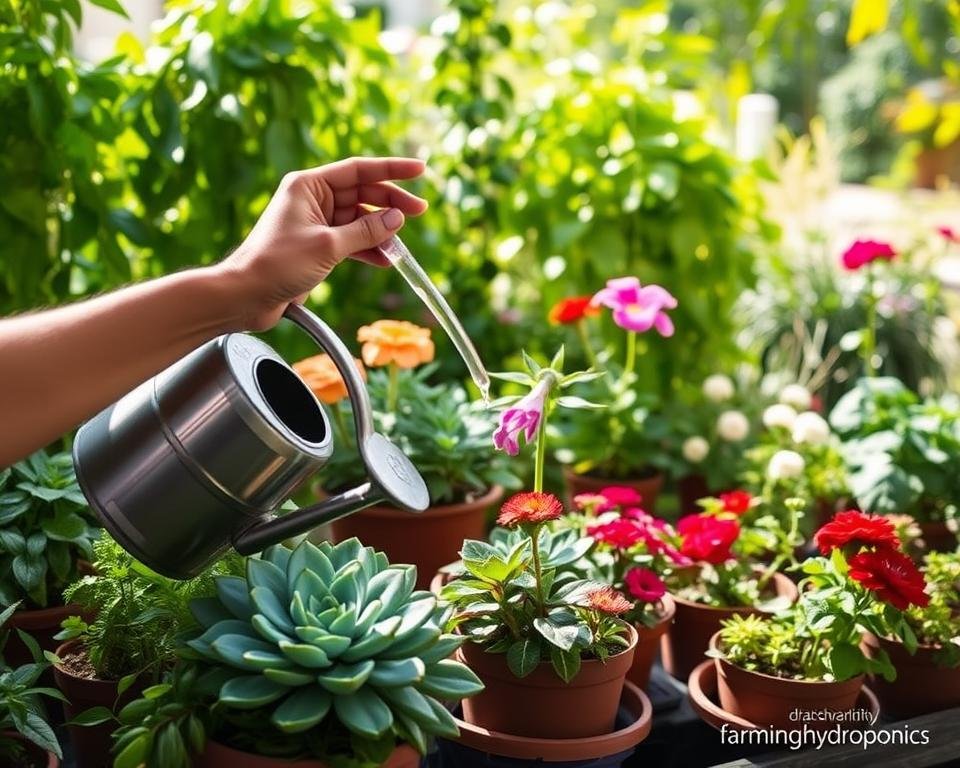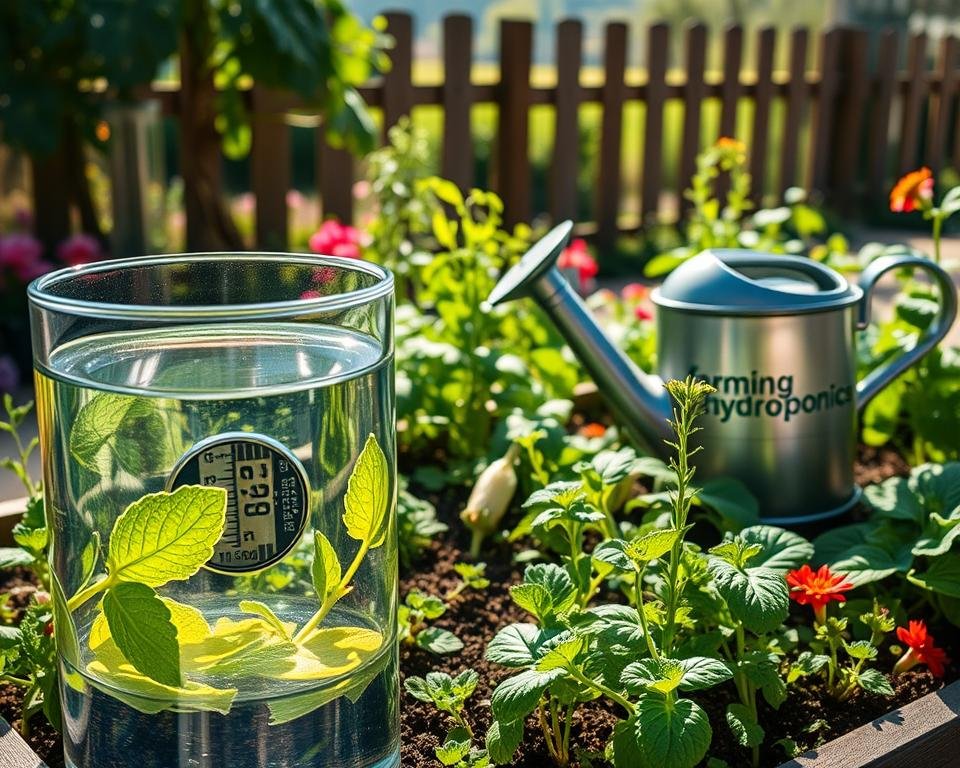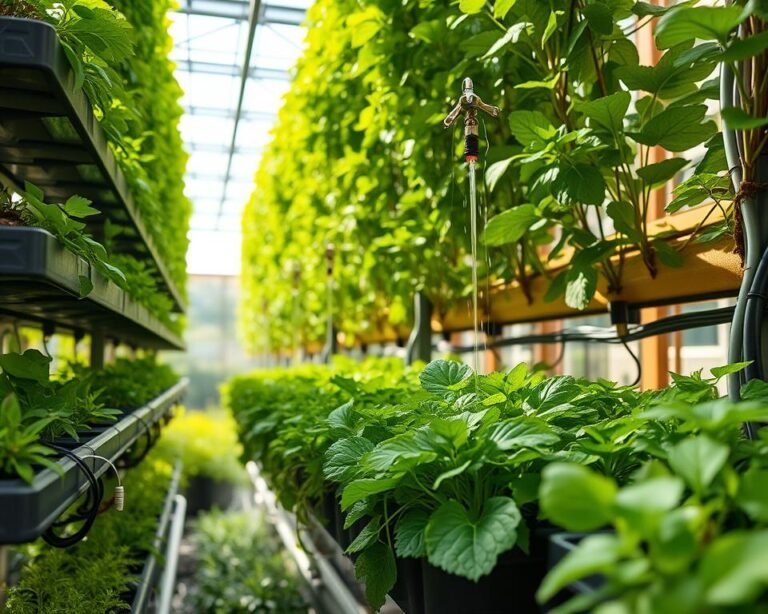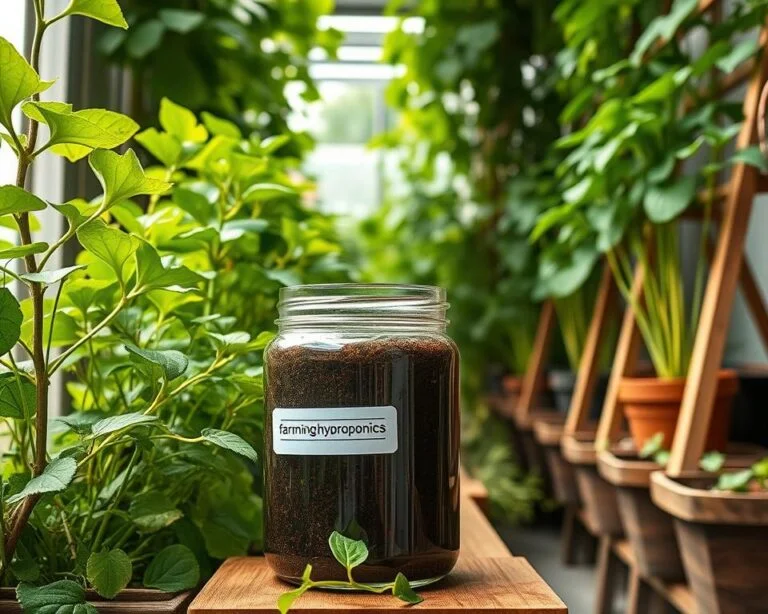Watering Techniques Guide for Container Gardens
Every plant has a story of survival. In container gardening, water is its most precious lifeline. I learned this the hard way during a hot summer. My beloved container herbs began to wilt, showing me that watering is an art, one best mastered with a solid watering techniques guide.
Container gardening faces unique challenges not seen in traditional planting. With less soil, plants rely on your knowledge of their water needs. A good watering techniques guide helps you go beyond basic care, ensuring your plants not only survive but thrive in tight spaces.
Understanding container gardening means knowing each plant’s water needs. Some plants drink a lot, while others can survive with little water. You need to be a skilled water manager, adjusting your care for each plant based on smart, practical guidance.
Key Takeaways
- Container plants need more careful watering because of less soil
- Different plants have unique water needs based on their type and growth stage
- Good drainage is key to avoid root rot and plant stress
- Watering in the morning helps reduce evaporation and keeps plants healthy
- Checking moisture regularly is essential for successful container gardening
Understanding Container Garden Water Requirements
Learning how to care for moisture in container gardens is key. These gardens have special needs that differ from those of traditional gardens. Knowing how to manage water is vital for your plants’ health and growth.
Critical Factors Influencing Water Needs
Several important factors affect your container garden’s water needs:
- Plant type and growth stage
- Container size and material
- Environmental conditions like temperature and humidity
- Soil composition
Recognizing Plant Thirst Signals
Watch for these signs to know when your plants need water:
- Wilting leaves that appear droopy or pale
- Dry soil that feels crumbly to the touch
- Leaves turning yellow or brown at edges
- Slow or stunted growth
Seasonal Watering Dynamics
Water needs change with the seasons. In spring and summer, plants need more water because they grow faster and it’s hotter. Smaller containers usually need water every day, while bigger ones hold moisture longer.
Pro tip: Always check soil moisture before watering to prevent over or underwatering.
By grasping these basic moisture management principles, you’ll become more skilled at caring for your plants.
Essential Tools and Equipment for Container Watering

Successful container gardening needs the right tools for water conservation and plant health. Soil moisture sensors are a big help for gardeners wanting to improve their watering.
Here are the essential tools you’ll need for effective container garden watering:
- Moisture Meters: These tools help you know when to water your plants
- Self-watering planters for steady moisture
- pH meters to check soil conditions
- Drip irrigation systems for precise watering
- Watering wands with adjustable spray patterns
New watering technologies can greatly help with water conservation. The Snip-n-Drip Soaker Hose System lets you customize irrigation for your garden.
Water-storing crystals are great for keeping moisture levels steady. They slowly release water, cutting down on how often you need to water.
Consider getting specialized equipment like:
- Rain barrels for collecting natural water
- Digital soil moisture sensors
- Programmable irrigation systems
Pro tip: Watering in the early morning cuts down on evaporation and saves water for your container gardens.
Choosing the right tools and knowing their uses can make your container garden more sustainable. It also helps with water conservation.
Watering Techniques Guide: Methods and Best Practices
Choosing the right way to water your container garden is key to its health and growth. Each method has its own benefits for your plants. Knowing these can help you use water wisely and make your plants grow better.

Container gardening needs careful water management. Each method, from deep root watering to advanced systems, has its own perks for your plants.
Top Watering Approach
Top watering means pouring water right on the soil. It lets you see how wet the soil is and water evenly. When using overhead sprinklers, remember to:
- Water at the base of plants
- Avoid wetting plant leaves
- Use lukewarm water
Bottom Watering Benefits
Bottom watering helps roots grow strong by placing containers in water trays. It makes plants grow deeper roots. Experts say it’s good for plants that like steady moisture
Drip Irrigation Systems
Drip irrigation is the most water-saving way to water your garden. It waters plants right at their roots, saving water and keeping moisture just right. The big pluses are:
- Less water used
- Even moisture
- Less chance of fungal diseases
Learning these watering methods will help your container garden grow well.
Water Quality and pH Management

Keeping water quality right is key for healthy container gardens. Your plants need the right water chemistry to grow well. The UN Environmental Program says pH is very important for plant health.
Water pH affects how plants absorb nutrients. Most plants do best in slightly acidic water, between pH 6.0 and 6.5. When picking water, think about these points:
- Tap water may have chlorine and minerals
- Filtered water can help plants get more nutrients
- Rainwater is a natural, chemical-free choice
Drought-tolerant plants and xeriscaping help with water quality. These methods use less water but still let plants grow well. Electrical conductivity between 1.5 to 2.5 mS/cm means good water for container gardens.
Testing your water is a must. The Environmental Protection Agency says to check often for contaminants. For container gardens, try these water quality tips:
- Use pH testing kits to check water acidity
- Filter tap water to remove chlorine
- Collect rainwater for natural watering
Water quality isn’t just about quantity—it’s about creating the perfect environment for your plants to thrive.
Smart Moisture Management and Conservation
Water conservation in container gardens needs smart planning and new methods. By using smart moisture management, you can have a healthy garden and save water. Good watering habits cut down water use and keep plants healthy.
Mulching Strategies for Moisture Retention
Mulching keeps soil moist in container gardens. Organic materials like straw or coconut coir help. They lower water loss and control soil temperature. Here are some mulching tips:
- Use organic materials like straw, wood chips, or coconut coir
- Apply a 2-3 inch layer around plant bases
- Avoid direct contact with plant stems to prevent rot
Soil Moisture Testing Techniques
Testing soil moisture is key. Knowing your soil’s water content helps prevent over or under-watering. Try these methods:
- Finger test: Insert your finger 2 inches into the soil
- Use digital moisture meters for precise readings
- Check container weight as an indicator of moisture levels
Water Retention Solutions
Save water in your container garden with smart techniques. Rain barrels are great for collecting and storing water. Here are some water-saving ideas:
| Solution | Water Savings Potential |
|---|---|
| Water-retaining crystals | Up to 50% reduced watering frequency |
| Specialized potting mixes | Improved moisture retention by 30% |
| Rain barrel collection | 500+ gallons per 1,000 sq ft of roof |
By using these smart moisture management tips, you’ll have a sustainable and water-efficient garden. It will thrive with less water.
Troubleshooting Common Watering Problems
Container gardening needs careful water care, as each plant has its own needs. Your garden’s health depends on spotting and fixing common watering issues. Signs like yellow leaves, wilting, or dry edges mean you need to act fast.
Too much water can cause root rot, with wet soil, brown leaves, and a bad smell. Not enough water stresses plants, making leaves curl and become brittle. A moisture meter helps you check soil and avoid these problems. Knowing your plants’ water needs is key to their health.
Fixing these issues involves changing how often you water and making sure water drains well. Make sure your container holds about 10% water. Sandy soils need more water, while clay soils need less but deeper water. Watching how your plants react and adjusting your care will keep them healthy.
Successful container gardening is all about finding the right balance. Look for signs of stress, check soil moisture often, and be ready to change your watering method. By paying attention to your plants, you’ll learn to create a strong and productive garden.







